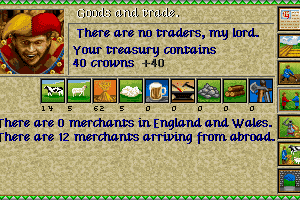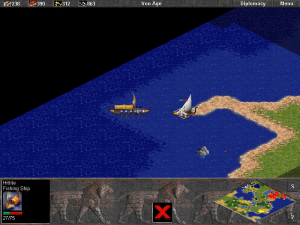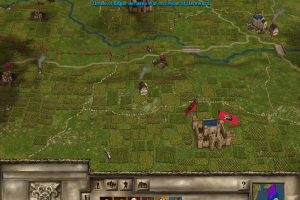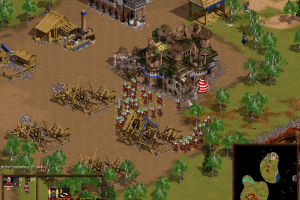Age of Empires II: The Age of Kings
Windows - 1999
Description of Age of Empires II: The Age of Kings
| The original Age of Empires sold by the million. The blend of epic historical conflict, real-time gameplay and silky presentation made it exceptionally attractive to mainstream gamers. The basic premise of taking a few villagers, gathering resources such as food, lumber, stone and gold, building up a settlement, developing an army and crushing your foes was not new, but Ensemble managed to make it look so good that it sold incredibly well. Yet at the same time AoE had a number of problems, primarily in the AI of the villagers and soldiers in the game - they failed to react to nearby events (like their friends being eaten by lions), and if asked to move from A to B would often get stuck at C (where in one case C was a single tree in the open). A patch pretty much fixed those problems, yet others remained - for example the interface was relatively basic, lacking any ability to set aggression levels for units, or to queue production orders. In a head-to-head feature count with the contemporary Total Annihilation, AoE looked as ancient as the Roman people it portrayed.
Our AoE review from late 1997 highlights the game's weaknesses, but it's also worth reading for a basic description of the game mechanics, which remain the same. Despite not being overly enamoured with the original, I'm happy to report that the improvements in the medieval follow-up Age of Empires 2: Age of Kings, while not individually ground-breaking, add up to a very impressive whole. In fact, there's a lot more improvements in the game than you realise, it's just that you take so many interface features for granted now, that you forget how many were absent from AoE 1. Rather than write up this review as a standalone piece, I'll skip over the game basics (see the above review for more details) and instead focus on what's new in this version, and how it affects the gameplay.
Game Styles
AoE 2 offers five campaigns of multiple scenarios, including a very good tutorial campaign. You can play through these at any of five difficulty settings, or you can instead generate a random "skirmish" map on which to face up to seven computer (or human) opponents. Multiplayer play is available on a LAN, or via Microsoft's Zone. The campaigns mix victory conditions quite well, and are far from easy to complete. The game setting is now Middle Ages, rather than ancient, so for example the Franks, Japanese and Teutons make up three of the 13 nations. Each nation has limits on which technologies it can develop (e.g. Vikings don't get access to the best cavalry, while Mongols don't get the advanced monk abilities), and each nation has distinct racial bonuses (e.g. Britons have archer bonuses) and a military unit unique to that nation (e.g. the Japanese Samurai). The excellent fold-out glossy chart explains all, and the technology tree can also be viewed from within the game itself, which is rather handy. Progression to new technologies is done as per AoE 1, with four Ages; as you upgrade your Town Hall through Dark, Feudal, Castle and Imperial Ages, new buildings, units and technologies become available for construction or purchase.
The first interesting new feature to report is the addition of random map templates. Rather than having some "truly" random map, AoE 2 lets you pick the style of map from one of around a dozen templates. One example is the Black Forest, in which the map is heavily wooded with paths connecting clearings; this sort of map is suited to a more defensive game where you can wall off and defend your enemies' avenues of attack. In contrast the Gold Rush map has one of the game's key resources, gold, predominantly in the middle of the map, so to mine it you have to be aggressive, attacking enemy miners while defending your own. Another of the styles, Fortress, sees you start out in a small walled town, so you don't have to worry about the initial buildup stages (if that's what you prefer).
There's also a new style of skirmish game called Regicide. In this variant you have a king to defend. If your king is killed, you're out of the game. In practice, finding and killing the enemy king is very hard, as a smart player will hole him up in a castle or similarly beefy structure, but the mere presence of this Achilles heel, which always gives the "losing" player some hope, adds well to the gameplay. The old winning conditions still apply - by conquest, by gathering all relics on the map, by building and defending a wonder (a special building), or by amassing the best game score. You can specify the size of map you want, and the number of opponents, so you can tailor the game to be as long and drawn out as you wish. Unlike the original, you can set the maximum number of units allowed for any side (by default this is 75, where AoE 1 allowed 50 units).
The game difficulty setting has a pronounced affect; the default "easy" level is certainly not that easy, particularly for a novice player. As it happens there's a setting below "easy", and that's where novice players should start out. The difficulty setting affects your initial resources and, more importantly, the rate at which enemy sides develop. It also restricts what the AI can do, e.g. whether it can move to the Imperial Age to gain the more advanced units and technologies. To see (and learn from) how the computer AI plays, you can play with the "visible map" option on - the default is for "fog of war" where you only see what your units can see. You can set which teams computer players are on in a skirmish game, and lock them to those teams; if you don't put each AI player on their own fixed team, they'll more than likely team up against you. For an interesting skirmish game you can assign an AI player to your team, and the AI player will announce its attacks, offering you the option of joining in. For a novice player, playing with an allied AI side against two solo AI enemies can be quite a good way to learn. Once you get the cartography technology, you can share map information with allies. Also, sides which team up share that nation's special team bonus (e.g. the Goths team bonus is that barracks produce units 20% faster).
The Looks
One of AoE 1's great selling points was its slick presentation. AoE 2 continues the tradition, offering resolutions from 800x600 to 1280x1024; I found the 1024x768 setting about right if you want to see enough of the map to co-ordinate battles but not have units appear too small. The quality of the artwork and the animations is high, with very few blemishes, walls built over undulating hilly land being one such minor failing. The cavalry animations are particularly good. The map can still only be viewed from one direction, and cannot be zoomed or rotated, an omission that games like Braveheart (though weak in other areas) put somewhat to shame. In deference, AoE 2 helps you avoid losing units behind buildings and trees by drawing the outlines of any obscured units.
The building artwork varies depending on which part of the globe your nation is from, and the speech from your minions is geared to the language of your nation. The sounds and music in the game are both very good. One "token" new graphic comes in the form of women villagers. This serves no gameplay purpose other than you being able to send all the women to do the real hard labour(!), although I must say I feel less easy killing female peasants with my heavy cavalry than I do their male counterparts. Such is war.
In Control
The game interface is where AoE 2 has probably improved the most. Most useful of all the tweaks is the ability to queue the building of new units; if you want five archers, just click the build button five times. There's also a "gather" flag that can be placed anywhere on the map for each production building. Combined, these features let you make and send new units to just where you need them. Of course, TA let you do this two years ago, so such a feature shouldn't be a surprise. The maximum size of the build queue depends on the size of the building, which also determines how many troops can be garrisoned in it; you can "hide" men by garrisoning them, which is a handy way to hide your strength from your enemy, but it also means your men recover faster if there's no healing monk to hand, and they can add to the attack strength of towers if you put men in them. By ringing the town bell, you can also garrison all your villagers in the town hall, which can then fire arrow attacks at your enemies. By ringing the bell again, the villagers return to their original work. A very simple idea, yet very effective.
While you can't queue orders for units, you can auto-build lengths of wall (a major omission from Tiberian Sun, simply because Westwood's design doesn't allow queued structure building), and you can queue the building of identical structures, such a guard towers or farms, which can be useful. Also useful is the "idle" button which takes you to any villager who's not been assigned a task. There are now "advanced" unit orders such as stance (aggressive, defensive, hold ground, don't attack) and guard, patrol or follow. Not all units get all the options though; for example monks can't "guard" units - this would be handy as an "auto-heal" method, but it seems the designers deliberately chose to force players to manually control their "field medics". As monks can also convert enemy units to your side, they're quite powerful for their small 100 gold build cost.
Perhaps the most innovative ability for military units is formations. This has two aspects. First, if you group mixed unit types together, then ask them to move they'll form up in such a way that the melee units are at the front and ranged units at the rear, and when they move they move neatly at the slowest unit's pace. If you have paladins escorting trebuchets (long-range artillery), the cavalry will trot in column ahead of the slow artillery units. If you mix swordsmen and archers, the swordsmen will move ahead of the archers. And if combat is engaged, these formations will hold. The formations also change to allow groups to pass smoothly through relatively narrow obstacles. Once in a while the pathfinding through narrow gaps will cause some unwanted wandering by your servants, but that's relatively rare. There are some "jitters" as the formations change facing, but these also generally aren't a problem. On top of that you can also specify one of four formation types - column, spread (to avoid artillery "splash" damage), square (to protect figures in the middle, perhaps healing monks) and flanking lines (to attempt a "pincer" attack). When combined with the de-facto group assignment orders (CTRL1-9 to set a group and 1-9 to select it) and aggression levels, warfare becomes very manageable in comparison to many other RTS games.
Gameplay
The designers have clearly made some attempt to evaluate the inclusion of features from other RTS games and, to their credit, have not been afraid to back down from "mistakes" made in the original game. The result is that, in general, managing your little empire has become rather easier, or less tedious, than it was before, and you can concentrate more on the "fun" side of the game (going back to a barracks to click "build" for each new unit was never fun in my book!). Yet there are still areas where Shelley and co. seem intent on forcing player micromanagement. The most irritating is with farms. To generate food, you'll generally use farms set up around a mill or town centre; every few minutes a farm becomes exhausted and must be rebuilt (re-sown) at the cost of some wood resources. While you get a text warning of the depletion, you can't click the event message to jump to the location (this would have been a very useful addition), and you have to remember to manually return to the farm, select the villager and right-click on the spent farm. Of course, with other "fun" stuff to do, you forget this, and soon your food production dries up. Very annoying, and it could have been avoided with a simple "rebuild farms automatically if I have X amount of wood in reserve" setting. Instead, Ensemble deliberately force this "guns or butter" policy on you (their words, not mine). The one saving grace here is that you can pause the game to give orders, so you can with patience avoid the gameplay degenerating to a click-fest.
There are other lesser examples of the artificial lack of intelligence of units. If I build a mine next to some stone to avoid my villager having to take the stone all the way to the town centre, why doesn't he (or she) automatically start mining the stone after the mine is built? When a structure is being attacked, a villager will stand right next to it and do nothing - I have to select him/her and manually order the repair. It's this sort of thing, like the monk issue I mentioned above, which makes me wonder how Ensemble decide what they think players should have to micromanage and what can be automated. Once I have a thriving village, which is well protected and defended, I want to be able to hand over the responsibility to "mine gold" to some AI assistant, so that I can concentrate on exploring the map, discovering new resources, finding potential enemies, organising my army, and building defensive structures and towers where the terrain allows me to. I suspect many more players are interested in "guns" and really don't want to deal with "butter".
The nature of the game, the way scenarios play, is quite similar to AoE 1 in many ways. The new interface and control methods help a lot, and the above issues aside, you do have more time to think about warfare. One good new addition is gates; you can insert gates in walls which let your guys through but not enemies. If you wish, you can build classic "inner keeps" around your important buildings and castle, with farms, mills and the like within the outer wall. I wouldn't go as far to say that the game encourages historical tactics, but the few "history lessons" in the game (via the campaigns and background information) don't feel too out of place.
When planning attacks, your tactics depend on the Age you've reached. Late in the game you'll have access to trebuchets, which have quite a range (a screen's width at 1024x768), and which can be limbered and taken around the battlefield with you. Unchecked, these can make mincemeat of any defence. Trebuchet duels are quite common. But the best way to take out such artillery is with a swift cavalry raid against the attacker, and so a wise player will have pikemen with his artillery to defend against the cavalry. There are quite large bonuses for certain types of units attacking others, e.g. pikemen against cavalry, and the glossy game chart lists these, as well as penalties (e.g. archers are ineffective against battering rams). This rock-scissors-paper element to the game is well thought-out, and adds to the cat and mouse feel of combat. Combined with working formations, it improves the game's "military" appeal considerably.
Another new feature is markets; by building a market you can trade (buy and sell) resources on a "virtual" marketplace. If you need more stone, sell your excess food, but beware the more you sell the lower the price falls, so the law of diminishing returns applies. Friendly fire, a frustrating feature of the original, has been toned down a little; while catapults still kill your own men, trebuchets are less lethal that way, so you'll lose a lot less men to your own artillery fire now. Town centres and castles have a defensive capacity, enough that they can mow down a good few attackers on their own; in fact if anything they're too powerful - Teutons (who have a town centre attack bonus) can aggressively place centres in enemy territory as an attacking weapon! These, and other subtle new features, all blend together well to make AoE 2 a marked improvement on the original.
AI
If you want to face the best opposition, then the Microsoft Zone is the place to connect to; there's consistently several thousand gamers out there ready to do battle with you. You can also create your own scenarios with the game's built-in editor. However, the solo AI is a very important consideration. The original AoE had a reasonable knowledge of how to build up a good economy and fighting force. The five levels of difficulty in AoE 2 essentially set the rate at which the AI sides build up; given that you can only set a single difficulty for all sides, this does mean that all your opponents will expand at very similar rates (which you can confirm by turning on the score indicators). The AI is very good at developing its economy, and will build up walled defences quite efficiently; unless you catch an opponent early on, you'll have some work to do.
The AI will attack in numbers, and use combined arms attacks to attempt to overcome your defences. Sometimes the combined arms are quite intelligent, other times the AI is somewhat "sacrificial" in its choices. If it probes your defence with archers and loses them to guard towers, you can be sure it'll send out a catapult next. If it sees a castle unguarded by cavalry it'll send in battering rams to take the castle down - a couple of battering rams can dispatch a castle very quickly. The AI will also make use of rams against perimeter walls. The one place the unit AI is still a little lacking is in peasant AI. Peasants at work often don't run when being attacked by non-artillery units, so it seems Ensemble are expecting you to make use of the town bell, or instead direct your own peasants to safety; but at the same time you have to direct your military in to the defence, so expect a fair deal of clicking... Military units attacking buildings will usually continue attacking even if being hacked by enemies; the secret here may well be careful use of the "guard" ability, such that your units will watch each others' backs more helpfully. There's also the "move to" command oddity where, just as in the unpatched TA: Kingdoms, units moving from A to B won't always respond to attacks en route if they can keep moving towards their destination (but unlike Kingdoms they will fight back if they're slower than the attacking enemy).
The Wish List
Aside from the micromanagement issue, which is something that affects all games of this ilk, my complaints are relatively minor. I'd like to be able to scroll the screen while drag-selecting units. I'd like to get more info info by hovering the mouse over a target, rather than having to select it to see that info. I'd prefer it if when you saved a game and quit, the detailed stats for the current game were not shown (OK, yes, I can shut my eyes at that bit...). I'm a little confused by some of the diplomacy aspects on lower difficulty levels; being able to offer tributes is fine, but attacking a side's units without starting a war is a little odd. The spoken words in the otherwise well-presented mission briefings are painfully slow, and the French and German accents rather corny, to say the least.
Some other gameplay additions would be good to see. One of my favourites would be the idea to allow peasants to recover rubble from destroyed or self-destructed towers; enough to make it worth doing but not enough to make stone too plentiful. A few things could be removed - while having sheep as an extra food source is fun, they can also be used as scouts, which is rather bizarre (though as soon as the sheep gets close to an enemy it joins their side...).
Overall
Age of Empires 2 is a marked improvement over the original. It adds so much to the gameplay that while the underlying concepts are the same, playing the game is that much more fun. While many of the interface improvements are only ones which bring the game up to par with its 1997 contemporaries, a number of others are innovative and very useful, such as the "town bell" and the "idle villager" button. Build queues, less constraints on population limits, soldier aggression levels etc all make the playing experience much more rewarding. Everything that's been added appears to have been put in for a sound gameplay reason. The markets allow resource swapping, for a price. The special units for each side, the army formations and unit strengths and weaknesses all improve the combat aspect.
When the game came out, a number of people made comparisons to Seven Kingdoms 2. My personal view is that 7K2 has several intriguing concepts which AoE 2 lacks, such as modelling the racial side of the game, and having an advanced spying system. Yet for all its clever aspects, 7K2 just isn't as much fun as AoE 2. Perhaps it is the historical tie-in that gives the Microsoft game the edge, but it's also more than likely the way certain game elements, such as markets and unit formations, have been introduced so seamlessly into the game, with each feature offering new choices and strategic options for the player. It also rates higher than TA: Kingdoms, first because most of the time it runs with no slowdowns (one of the Joan of Arc missions gets a bit treacle-like), but also because the strategic options and the variety within units for each side both make the play, well, more interesting. AoE 2 add a lot to the original, where Kingdoms really did not (in fact, the sci-fi setting suited its predecessor much better).
AoE 2 has its shortcomings; the most irritating being the necessity to revisit farms to re-plant them regularly. Yet the game gets it right in so many other areas, a fair few of which are quite innovative and which may be adopted in other games. The solo game has longevity through five enjoyable campaigns, a good random map generator and a scenario editor, and beyond that the multiplayer experience is excellent. Sure, the game has a lot in common with its predecessor, but the new cannon and musket units, the long range trebuchets, and the shift 1,000 years forward all help to bring an enjoyable new feel to the action. While those of you with hypercritical eyes will argue there's room for improvement, AoE 2 is the best RTS game of the year to date, and as such is worthy of our GDR Gold Award.
Review By GamesDomain
Age of Empires II: The Age of Kings has an addon available: Age of Empires 2: Von Kimbern und Teutonen, don't miss it!
External links
Captures and Snapshots
Comments and reviews
Coolio Myniggaplease 2022-10-28 1 point
A excrecentíssima juíza de defeito Cavalaryssa Diabólica Cu ordena que o réu da puta que me pariu pague a prestação do artigo bosta da lei merda combinado com a lei do cu da mãe Joana. Ainda neste feito, determina que a gostosa Gianna Bah Má-Carne (afinal, a carne é fraca), também conhecida como esposa do sr. Berrugão, seja nomeada sua assistente judicial gerencial anal. O motivo da nomeação é o seguinte:
1.A Gianna é amiga pessoal da juíza;
2.A Gianna é gostosa;
3.Revogam-se as disposições anais em contrário.
Cumpra-se o caralho na bunda!
Publiquem-se fotos do pênis (como a Cavalaryssa dizia: "Ai, qui dilícia!")
Registre-se no cararólhio.
Intimem-se a negada pra briga de torcidas anais.
Como diria: Cu!
Marco 2022-10-09 0 point
Also, I remember the classic game. "Age of Kings" and "The Conquerors expansion". My parents gave the Gold Edition to my brother and me as a christmas present: a big box containing the aforementioned games, a front/rear manual for both titles (front side: Age of Kings basics of the game and civilisations' technology tree; rear side: The Conquerors expansion, with all game changes, new units and new civilisations' technology tree) and a generic technology tree in a separated sheet showing the British longbowman as a unique unit. I think it was 2002 or 2003. Unfortunately I lost almost everything, The Conquerors CD scratched and is now lost, Age of Kings CD unable to install the game. I can't even find the manual and the tech tree sheet.At least I saved a PDF version of AoK manual because it was part of CD content and I didn't know about it for so many years... Then I checked on Steam and Microsoft Store and looked at HD and DE to compare. So I got DE (see previous post).
Marco 2022-10-09 0 point
I got Definitive Edition on Steam because it comes with campaigns that on HD Edition you would need to purchase as a separate DLC.
Yusufylmz1986 2022-09-18 0 point
https://youtu.be/1TsHOYEpDKM
Age of Empires ortaya çıkış hikayesi gayet ilginç. Hazırladığım videodan izleyebilirsiniz.
BitchGamer 2021-04-29 0 point
why do u have to pay for an old game like this if you are giving sims and other games away for free?? makes no sense to me.....
Write a comment
Share your gamer memories, give useful links or comment anything you'd like. This game is no longer abandonware, we won't put it back online.
Buy Age of Empires II: The Age of Kings
Age of Empires II: The Age of Kings is available for a small price on the following websites, and is no longer abandonware. You can read our online store guide .
Game Extras and Resources
Some of these file may not be included in the game stores. For Age of Empires II: The Age of Kings, we have the following files:
Similar games
Fellow retro gamers also downloaded these games:

















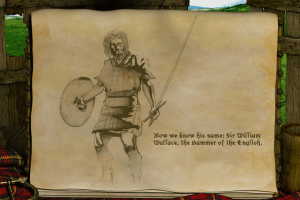


















 3 MB (Windows)
3 MB (Windows)